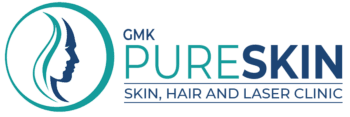Team Members
Our Professional Team
Best Skin Pigmentation Treatment in Sangvi | Pure Skin Clinic
Pure Skin Clinic is a top provider of skin pigmentation treatment in Sangvi, specializing in addressing a wide range of skin concerns, with a primary focus on pigmentation issues. Our team of highly qualified experts and seasoned dermatologists is dedicated to offering the best solutions for the needs of your skin. We offer state-of-the-art dermatological treatments to people in Pune who desire effective, long-lasting results.
What is pigmentation of the skin?
Skin pigmentation is also called the natural color of people’s skin based on the elemental melanin. It is created in cells called melanocytes which are found in the skin – more precisely in the outermost layer of the skin, the epidermis. The main purpose of melanin is to act as a shield to the skin against unfavorable rays from the sun and thus prevent an attack on DNA and skin diseases.
Skin color genetics or differences originate from the amount, type, or distribution of melanin, and they are contingent on genetics, Ultraviolet irradiation, hormones, age, and disease. Although it commonly plays the role of a color-producing element in the skin, fluctuations in melanin production cause skin pigmentation disorders. These include conditions like; hyperpigmentation (dark spots or patches) hypo pigmentation (light patches or absence of color), and other pigmentation disorders.
Types of Skin Pigmentation
Skin pigment diseases are closely related to an abnormality of melanin synthesis. These disorders can result in either an increase in skin pigment or a decrease in skin pigment. Below are the main types:
- Hyperpigmentation
This is a skin condition according to which the skin manufactures more melanin and forms comparatively darker patches than the other areas of the skin.
- Hypopigmentation
This may occur due to low melanogenesis or absence of melanogenesis whatsoever which results in the formation of blanched colored portions or regions on the skin.
- Other Skin Pigmentation Conditions
Pigmentation Disorders from Medications: There are cancer treatment drugs that cause pigmentation that is not normal and that is referred to as chemotherapy.
Causes of Skin pigmentation
The causes of skin pigmentation can be quite different depending on which type of skin pigmentation disorder is in question. Here are the main causes:
- Hyperpigmentation Causes
– Sun Exposure: It will be seen that UV rays cause melanin production that results in the development of dark spots or sunspots.
– Hormonal Changes: Various skin conditions like melasma are related to hormonal changes for example during pregnancy period, the menopausal period, or when the woman is using contraceptive pills.
– Post-Inflammatory Hyperpigmentation (PIH): This happens after skin injuries, inflammation, or some forms of acne, in which melanin is produced in large amounts.
- Mixed Pigmentation Causes
– Genetic Mosaicism: It is possible that people end up having some areas of their skin darker or lighter in comparison with others because of genetics.
– Chronic Inflammation: Diseases such as eczema for example have an impact on skin texture and color because the skin is inflamed for so long.
- Others Pigmentations:
– Birthmarks: Mongolian spots or café-au-lait spots that appear at birth or during infancy that may develop into malignant melanoma in adulthood.
– Hori’s Nevus: A non-syndromic, gray-brown hyperpigmentation observed in some populations due to the function of dermal melanocytes.
It is therefore easier for dermatologists to advise on the best treatment course to employ and this includes; topical medication, laser treatment, or even preventive measures like using a screen or to avoid further accumulation of skin pigmentation.
Skin pigmentation treatments
Here are the common Skin Pigmentation Treatments in Sangvi options for managing and reducing Skin Pigmentation
- For Hyperpigmentation
– Hydroquinone: It also helps to lessen the darkness of the spots because it lessens melanin levels and it is present in all types of regimens.
– Retinoids: Topical products like tretinoin assist concerning cell shedding rate and skin color as well.
– Vitamin C: Antioxidant creams function primarily in inhibiting the formation of the melanin pigment and inhibiting skin oxidation.
– Kojic Acid: It can whiten the skin by interfering with the enzyme that is used to color our skin and hair – melanin – from functioning.
– Azelaic Acid: Intake can reduce inflammation and also help in erasing the dark skin, especially in the areas with a condition PT IH.
– Chemical Peels: Glycolic peel salicylic acid and lactic acid peels can be used as exfoliation therapy because this treatment eliminates the outer layer of the skin with pigment and allows the formation of new skin that can be of equal tone.
- For Hypopigmentation
– Topical corticosteroids: Minimally reduce inflammation and encourage repigmentation assistance in conditions such as vitiligo.
– Calcipotriol: In vitiligo, it is employed for repigmentation by balancing skin melanocytes function.
– Psoralen therapy (Topical PUVA): This is the undertaking of the drug psoralen drugs followed by exposure to ultraviolet light as a way of promoting melanocyte activity.
– Laser Treatments:
– Laser toning: A mild laser therapy that may assist in the skin coloration restoration of areas affected with vitiligo.
– Micropigmentation:
– Tattooing: Where large areas of the skin are affected, the treatment can use color from other unaffected areas of the skin.
- For Mixed Pigmentation
– Combination Therapy – Depending on the patient’s skin’s pigmentation problem, the dermatologist might prescribe topical medications, laser therapy, and chemical peel for hyperpigmented and hypopigmented regions respectively.
– Prevention – This disease is also strongly associated with ultraviolet radiation; therefore, wear sunscreen products to avoid aggravation of problems with pigmentation.
- The Treatment of Pigmentation Disorders
– Hori’s Nevus – Laser therapy is used in order to act directly on the areas with higher concentrations of pigments.
– Birthmarks – Other treatments for birthmarks include Laser therapy or cryotherapy, where the skin is frozen, in a bid to reduce their coloration.
Frequently Asked Questions (FAQ)
No, but treatment is available.

